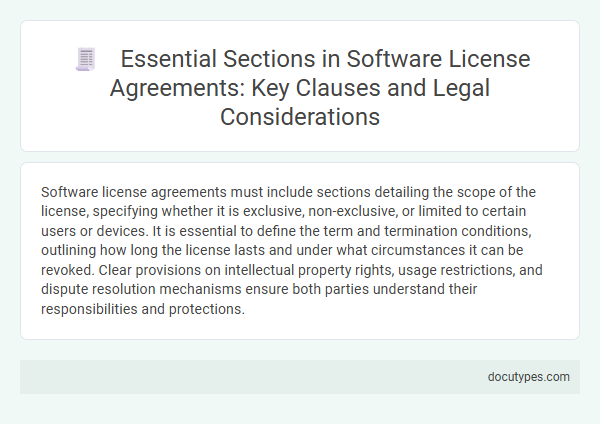Software license agreements must include sections detailing the scope of the license, specifying whether it is exclusive, non-exclusive, or limited to certain users or devices. It is essential to define the term and termination conditions, outlining how long the license lasts and under what circumstances it can be revoked. Clear provisions on intellectual property rights, usage restrictions, and dispute resolution mechanisms ensure both parties understand their responsibilities and protections.
Introduction to Software License Agreements
What are the essential sections in software license agreements? Software license agreements define the terms and conditions under which software can be used, distributed, or modified. Key sections ensure clarity on usage rights, restrictions, and liabilities, protecting both licensors and licensees.
Grant of License: Scope and Limitations
| Section | Description |
|---|---|
| Grant of License: Scope and Limitations | This section defines the rights granted by the licensor to the licensee, specifying the extent of usage permitted for the software. It outlines whether the license is exclusive or non-exclusive, perpetual or time-limited, and if it covers a single user, multiple users, or enterprise-wide applications. Restrictions on use, such as prohibitions on copying, modifying, sublicensing, or reverse engineering the software, are clearly stated. This section ensures clarity on how You may legally use the software and protects the licensor's intellectual property rights. |
Intellectual Property Rights and Ownership
Software license agreements must clearly address the allocation of intellectual property rights to protect both the creator and the user. Defining ownership ensures you understand how the software can be used, modified, or distributed.
- Intellectual Property Rights Clause - Specifies the rights granted to the licensee and protects the licensor's proprietary interests.
- Ownership Declaration - Clearly states who holds the copyright and any patents associated with the software.
- Use and Restriction Terms - Outlines permitted uses and restrictions to prevent unauthorized copying or modification of the software.
Restrictions and Acceptable Use Policies
Software license agreements must clearly define the Restrictions and Acceptable Use Policies to ensure proper and legal usage of the software. These sections protect the intellectual property and outline user responsibilities.
- Restrictions on Use - Specifies prohibited actions such as unauthorized copying, reverse engineering, or distribution of the software.
- Acceptable Use Policies - Defines permissible activities to maintain compliance with legal and ethical standards.
- Consequences of Violation - Details penalties or termination conditions if users breach the restrictions or acceptable use guidelines.
Clear Restrictions and Acceptable Use Policies are essential for safeguarding software rights and guiding user behavior within licensed terms.
Payment Terms and License Fees
Payment Terms and License Fees are critical sections in software license agreements, outlining the costs and schedule for using the licensed software. Clear definitions of fee structures, including one-time payments, subscriptions, or royalties, help prevent disputes and ensure mutual understanding. You must review these terms carefully to align with your budget and usage requirements.
Maintenance, Support, and Updates
Maintenance, Support, and Updates are crucial sections in software license agreements that define the obligations of the licensor to ensure software reliability and performance. These sections specify the terms for bug fixes, technical assistance, and software upgrades, which help sustain the software's functionality over time. Your understanding of these provisions ensures continued access to essential services and protects your investment in the software solution.
Warranties and Disclaimers
Warranties and disclaimers are critical sections in software license agreements that define the scope of guarantees and limitations of liability. These clauses protect both parties by clearly stating the software provider's commitments and any exclusions of responsibility.
Warranties typically specify that the software will perform as described and meet certain standards for a defined period. Disclaimers limit the provider's liability for issues like errors, interruptions, or damages resulting from software use. Understanding these sections helps you assess the risks and protections involved in the agreement.
Limitation of Liability and Indemnification
Software license agreements must include key sections to protect both parties effectively. Limitation of Liability restricts the extent to which one party is financially responsible for damages, ensuring risks are managed.
Indemnification requires one party to compensate the other for specific losses or claims, providing further protection in case of third-party claims. These clauses collectively define financial and legal responsibilities, creating a balanced agreement.
Term, Termination, and Renewal Provisions
Software license agreements must clearly define the Term to specify the duration of the license grant. This section establishes the period during which the licensee can legally use the software.
Termination provisions outline the conditions under which either party may end the agreement early, protecting both licensor and licensee interests. These clauses typically address breach of contract, insolvency, or non-compliance issues.
Renewal provisions determine whether the license will automatically extend after the initial term or require renegotiation. Clear terms about renewal help avoid disputes and ensure continued software access for Your business needs.
Including detailed Term, Termination, and Renewal sections is essential to managing rights, obligations, and expectations in software license agreements. Properly drafted provisions safeguard both parties throughout the life of the contract.
What Sections Are Essential in Software License Agreements? Infographic

